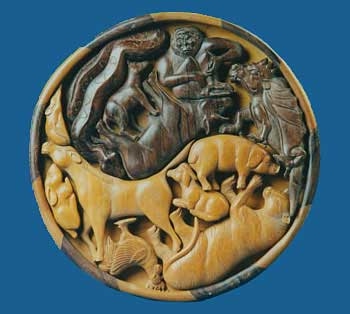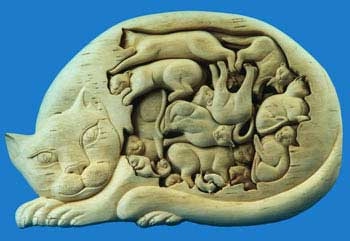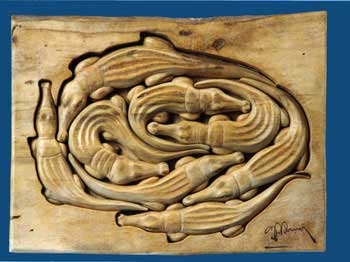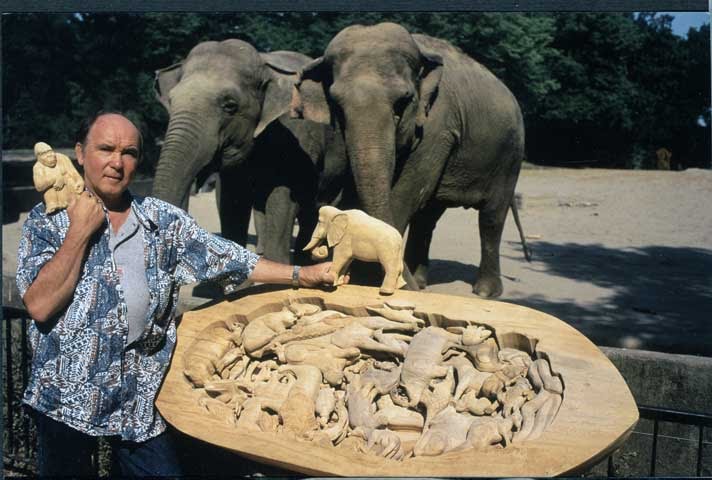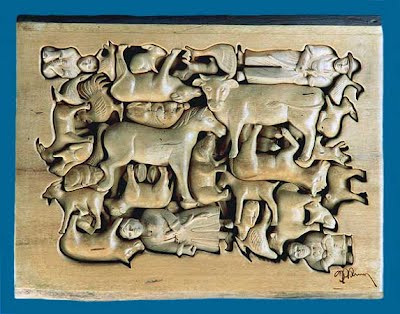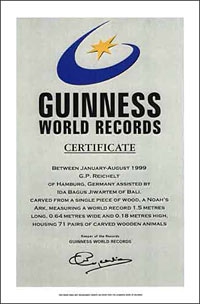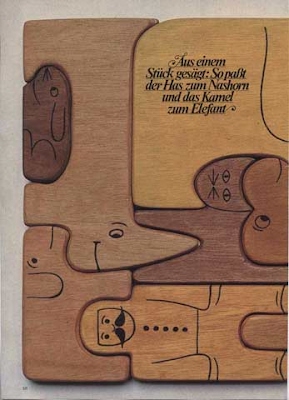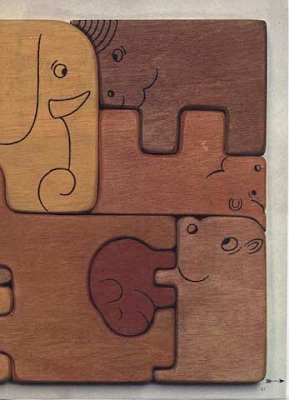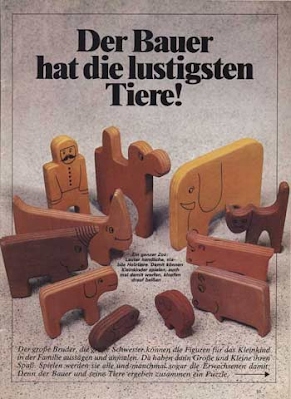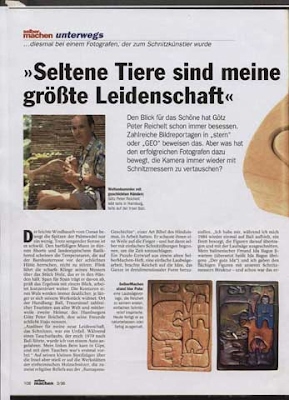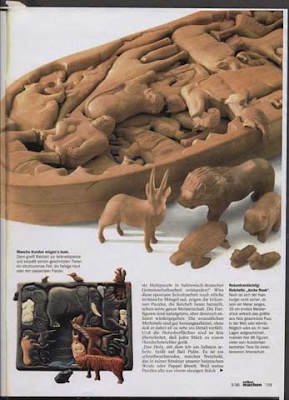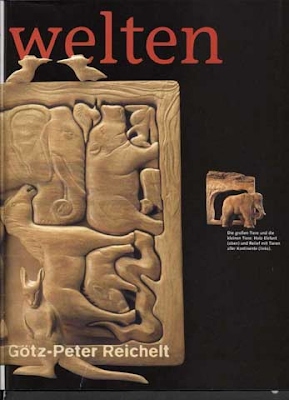Cluster Puzzles of Götz-Peter Reichelt Götz-Peter Reichelt (1943–), an ex photographer and now wood carving artist from Hamburg, Germany, but primarily based in Indonesia and Bali, can be described as a major figure in the cluster puzzle genre, in both inherent quality and longevity. Bali, incidentally, is famed for wood carving. In addition, or as well as to ‘normal’ animal wood carving, he has created a most impressive and substantial collection of themed cluster puzzle works, with a variety of animals, all carved in his favourite medium, wood. A variety of woods are used, with Pulai favoured (a common wood in Bali), and others, including Ebony, Australian Jarred, Yellow Nanka, Pinewood, Chempaka, and even driftwood. Typically, the wood is left uncoloured, although colour is occasionally used. A feature of the puzzles, not generally seen in other cluster puzzles, is of the third dimension. The first puzzles date from 1975 onwards, with ‘The Children’s Zoo’, and of which he has consistently produced new work up to the present day, albeit with a decided interlude between 1979 and 1990. This is partly explained by his move to Bali, in which he had to go back to his photography work to pay the bills, as no one was interested in buying the puzzles. The general design is to have a few animals closely interlocking, with any ‘inconvenient’ gaps filled by smaller animals. These are all of an animal or (more rarely) a human motif, and pleasingly, without exception are all of a themed nature, which gives a pleasing additional coherence to the puzzle overall. These include Nativity scenes, Zoos, Noah’s Ark, Chinese yin yang or all of a single animal, such as cats, crocodiles, dogs, frogs, geckoes, pigs and whales. Another feature is the frame in which they are surrounded, in which this is taken from the wood the animals were created from, to give birth from if you like, thus giving a certain, and pleasing, unifying concept in the round. The puzzles vary in being of true tessellation, with a slight rounding off, and so leaving gaps to greater or lesser degrees. However, these are indeed are based on tessellation principles, and any rounding off is most minor. Here, the main aim is of the veracity of animal portrayal, rather than allowing these to be too distorted by adhering to a strict tessellation premise. His masterpiece can arguably be considered as a (giant) Noah’s Ark, of 1999, which is a magnificent sight. This consists of 142 pieces of 71 distinct animals, 2 of each type, and a majestic 1.5 metre in length, and which took six months to produce! Indeed, this featured in the Guinness Book of World Records of 2000 (see certificate), as the largest wood puzzle of its type. Putting an exact number on the puzzles is a little difficult, as there are many minor variations, sizes, styles and numbers of motifs for any one theme; however, about 22 distinct themed puzzles are identified, with total numbers produced as an estimate running of about 783. In contrast to other artists, Reichelt freely discusses his work on his extensive website, and of which I wholeheartedly recommend a (long) visit. Also on the site is his numerous press cuttings in German newspapers, and he also tells me of appearances in DIY magazines, such as Selbermachen and Das Tier. all the above I discuss in much greater detail below. All pictures © Götz-Peter Reichelt.
The Beginning Of interest is what led to the puzzles, beginning in 1975. Was it an independent discovery, like many others, or was he inspired by others, such as the famed Italian designer Enzo Mari, whose cluster puzzle work dates from 1957 or the tessellation expert M. C. Escher? In short, it can be said to be an independent discovery, and primarily, it grew out of his interest in drawing, animals and their welfare, an interest from boyhood. Only later did he come familiar with Mari’s work (as is shown on the inside back cover, with a picture of 16 Animali), in 1985, when he went to the Museum für Kunst und Gewerbe (Museum for art and trade) in Hamburg and discovered by chance the puzzle of Mari. He was also aware of Escher (albeit not mentioned in the book), but he was only familiar with his non-tessellation works, such as Waterfall and Ascending and Descending. Although Escher is not mentioned, he told me that he was indeed aware of him but did not particularly influence him. The premise of animal welfare and the environment promotion underpins much of the subject matter. Tier welten Pleasingly, Reichelt has self-produced a book/catalogue, Tier welten (Animal worlds), in German, of 44 pages, primarily to accompany his work at exhibitions. For any enthusiast of cluster puzzles, it is a must, in which he gives a detailed history, a general discussion and is profusely illustrated, in colour throughout. Although not stated as wholly of his cluster puzzles, it overwhelmingly is; only occasionally is a non-cluster puzzle included, such as Rhinoceros. As the book was published in c. 2003, or not updated since, more recent puzzles that feature on his website are thus not naturally shown. It is available as a hard copy from the author for €12, or alternatively, as a free download from his site (see links below).
Commercial Premise/Exhibits Of interest are which puzzles were a commercial success. The two most popular puzzles are the Children’s Zoo, in different variants, of 140 puzzles and Nativity scenes, of 50 puzzles. Both are fully understandable in different ways. The zoo puzzle has obvious appeal of generic animals, whilst that of Nativity, being more focused, will also appeal, especially at Christmas time. Most are available for purchase on his website, with prices ranging from 60 to 1000 Euros. If so desired, a sold work can be recommissioned. Of interest is the market outlet. His main success is with crafts and Christmas markets in his native Germany, rather than his website, galleries, museums and puzzle companies as may otherwise have been thought. Indeed, he is largely thwarted in his efforts to market these at all! Surprisingly little is sold directly through the website. Indeed, he told me that he only had three sales in ten years! Of puzzle companies, Ravensburger Spiele was offered the puzzles to cut in cardboard but they were not interested. All this is a typical frustrating situation of the one-person business regarding puzzles; it is very much a cottage industry, without the backing of a major company. It is certainly no reflection on the quality of his work. A possible alternative to each unique carving is that of mass-producing, in plastic. However, he tells me that he does not like this medium, it being against the principles of animal welfare. Below are shown exhibits at Hamburg and Lübeck. A full listing is given at the foot of the page. Reichelt at his stand in the Völkerkunde Museum in Hamburg, November 2018 Reichelt working during his exhibition in Lübeck, Perti Kirche, December 2018 Preliminary Sketches/Design Process Of interest is the preliminary sketches that lead to the finished design (and incidentally not just here but with other artists). It is interesting to compare and learn how the design progressed and so in the process advance one's own studies. To me, the underlying work is just as interesting as the finished pieces, although of course, for obvious reasons, the drawings underpinning this are not generally seen. However, Reichelt can be described as one of the few exceptions in that he shows the preliminary sketches, as a few such instances can be found in the book, albeit largely serving as background and are not discussed as such. However, upon correspondence, he has shared with me many more of the sketches, a few of which I show here. These all follow, not unnaturally, in the same style, with the general design process being to have as many animals closely fitting, and ideally interlocking, as possible, with any ‘inconvenient’ gaps filled by smaller animals. Cats, left; Double Blue Whale, right Inventory (The ‘18 Puzzles’) Of interest is an inventory of the various works. However, this is not a straightforward task as otherwise may be thought, as there is not a simple, one-to-one correspondence; there are many variants, in different ways, to consider. The book, in ‘Objektaufstellung’, in chronological order, gives an inventory of sorts as a list of the core value puzzles, but without specific details as to variants beyond stating as a variation, such as with two Children’s Zoos, Chinese Horoscopes, and Whales. To this end, I then pursued the matter with Reichelt. From information kindly supplied by him, it is possible to be more exact. There are a core 18 puzzles, albeit even here, there are variations. To be more exact on what the variations entail, there might be different woods, differences in size large or thickness, and colours, rather than just the shape of the outer plank, style of frame (nativity scene), as well as variations in design. For any one puzzle, there are numerous repeats, along with variations. The numbers are generally qualified by ‘about’. As best as can be determined, the inventory is as follows: 1. Children’s Zoo. About 176 puzzles in about 12 variations 2. Pigs. About 63 puzzles in about 5 variations 3. Zoos. 84 in about 8 variations, this puzzle is also the counterpart of the first Noah's Ark 4. Whale. About 72 puzzles in about 5 variations 5. Nativity. About 93 puzzles in about 10 variations 6. Frogs. About 56 puzzles in some 5 variations 7. Chinese horoscopes (first design). 23 puzzles in may be 3 variations 8. Chinese horoscopes (second design). About 59 pieces in about 12 variations 9. Cats. 33 puzzles in about 4 variations 10. Whales and Fishes. About 174 puzzles, in about 20 variations 11. Noah's Ark. 23 puzzles, each of them in variation from another on, most 2 layers and the big one has up to 4 layers 12. Gecko. 39 puzzles, in about 5 variations 13. Farm. 16 puzzles, all with the same layout but different shape of the planks 14. Dog. 13 puzzles, in 2 variations 15. Crocodile. 10 puzzles, in 4 variations 16. Dolphin. 42 puzzles in many variations 17. Jungles. 14 seven jungles in 3 variations 18. Chess. 2 sets of the chess game, which is indeed also a puzzle without an outer frame but not in the position might see them inside this box. This gives an approximate total of 783 puzzles including variations, which is mightily impressive however you look at it! This must surely be the highest number of cluster puzzles produced by any one person. Below each picture is some commentary, taken from Reichelt’s own text, where available, from his book and/or website, or private correspondence. Again, this is not always entirely satisfactory, at least for my purposes. The book commentary, of which I translated using Google Translate, gives a broad general discussion in the round, but not entirely consistently, and to differing degrees of depth. On the website, although more focussed on individual puzzles, this is in general not in particular detail as to the intricacies of puzzles themselves, but rather it is basic detail, for would-be purchasers of the puzzles. In addition to Reichelt's commentary, I also add my thoughts, and also make minor corrections to the English and punctuation of the translation.
1. The Children's Zoo, 1975 (Kinderzoo), 10 Figures. About 176 puzzles in about 12 variations. Tier welten pp. 1–2 GPR website: Children zoo with 10 animals and a zoo warden. DB: The first puzzle. Although discussed ostensibly over pages 1–2, this is more background detail as to the beginning of his interests in animals and puzzles, rather than the puzzle itself. Therefore, I do not add those comments. Four different versions are given: (i) of true interlocking, of differently coloured woods without the third dimension, (ii) carved in three-dimensions, uncoloured and (iii) carved in three-dimensions and hand coloured, and (iv) carved in three-dimensions with wood in different colours. Of note is that the ‘basic model’ of (ii) is thus set in place, and of which has changed little, if at all, throughout the years.
2. Pigs, 1978 (Schwein), 13 Figures. About 63 puzzles in about 5 variations. Tier welten pp. 3–4 Tier welten: For some people, when it comes to giving something, I make a special effort to find something out of the ordinary, preferably homemade. A friend who collects pigs and her 30th birthday was the reason to design this pig puzzle. I was looking for something unusual, and I came up with the pork puzzle idea far too late. With the lucky pigs, she was supposed to sweeten the transition from the er to the he. For a long time I had little experience with carved wood and tools. Pig shapes can be easily folded together. The legs are short, the bodies round and pliable, and so the sketch was soon started. The group of ten large bristle cattle stood relatively quickly. To fill the gaps, I filled them in pairs with small piglets until I reached 30. When asked how I should present this slightly falling pigsty, the glorious thought that the 31st To put the year of life in the form of a pig frame around 30. The idea was just born that I would later use in many other puzzle designs. Unfortunately I only had a pine board when I really wanted to start on Saturday night. But if it should start when the internal clock has rung, then the momentum will no longer be delayed, even if the material is not 100 percent correct. By Monday I had also cut my left thumb and had to pause. Nevertheless, the first carved puzzle was completed on time and the joy was huge. Like the children's zoo, the pig jigsaw, later also in a simplified form, landed at a handicraft newspaper and enjoyed good demand. This led the editor in charge to encourage me to create another draft. GPR website: ...piglets surrounded by a big mother pig. DB: Although discussed ostensibly over pages 3-4, this is more background detail as to the reasons for the creation, of a present for a friend, a pig collector, on her 30th birthday. Of note here are the pigs, where the motifs are encased in the same creature, a mother pig to which she has given birth to. Also see Cats, Dogs, Frogs, and Geckoes as for other examples of the same idea.
3. Zoo, 1978 (Zoo), 29 Figures. 84 puzzles in about 8 variations. Tier welten pp. 5–6
Tier Welten: I couldn't quite detach myself from the children's zoo motif. So a new zoo was created, partly with other more realistic animals. In terms of proportion and size, they are not all coherent with each other, but are still lively. Submit puzzle. With this zoo, I also laid the foundation stone for a much later object. Although my dream destination of my youth was actually Japan, I landed on the beautiful island of Bali years later and immediately felt at home. Did the famous Balinese "wood carving art" lure and enchant me on the island? I will probably never be able to answer this exactly. Certainly only my designs have little to do with Bali. Fascinated by the carvers in the interior, the carved bacillus that had fallen asleep had once again attacked me. Only a few simple gifts emerged. I discovered Balinese carving tools and got to know the Pulai wood, which is important for my carving. GPR website: The big zoo with a rabbit, rhino, buffalo, piglet, frog, tiger, elephant, mouse, horse, kangaroo, hornbill, wild boar, snake, squirrel, duck, hippopotamus, and cat, all together some 29 animals, that can stand alone only dolphin and salmon have to swim. Made from one piece of Pulai wood, size 56x46x3cm DB: The first big Zoo puzzle, with a variety of animals, of a decided increase in number from the earlier Children's Zoo. 4. Whales, 1991 (Wale), 21 Figures. About 72 puzzles in about 5 variations Tier Welten: Somehow it was in this Bali period when a newspaper article about stranded and horribly dead whales touched me particularly deeply. Worse, a few days later, the announcement that both Japan and Norway wanted to go whaling on flimsy grounds. I immediately wanted to design a puzzle with marine mammals in protest. But I lacked the brilliant idea in the draft to reconcile the protection ideas with the great agility and group dynamics of the whales. Of course I am also not a marine biologist and therefore did not have the animal-specific differences ready. Quite some time later, during a trip to Australia, I saw what I was missing. A poster with almost all whales, well proportioned and sufficiently drawn. Now the spark jumped and I got to work. In Bali, I had carved my three puzzles from Pulai wood again from home and optimized my technique. In the meantime, unnoticed, the children's zoo motif was stolen and made the original mother of Balinese puzzle carving. From then on, I wanted to be more careful with my designs and first set up a workshop where I could hide my sketches more easily. In addition, I didn't want all the wood shavings and dust on my porch anymore. The only thing left to do was to create the designs, and I was right in the middle of the whales. Surprisingly, major design problems arose. How should the mighty tail fins come into their own when the wooden board is only two to three centimeters thick? What is the position of the whales in relation to the direction of wood growth so that a certain stability is achieved? Trying out was my motto here. When I thought the design was pretty good, I started carving and soon realized that the fluke problem was far from being solved for the big whales. I needed more space for the tail fins. This is how the solution to the stacked animal parts was created, which was also a good protection from curious imitators, because you couldn't see all the animals completely. The second prototype then brought it. Now the whale ensemble had something alive, the mammals scurried around the tail fins in their “aquarium” but I had to do a trick for the first time. So far, all other puzzles were made from a single piece of wood (30x40x3cm), so because of the large flukes and the layering, I had to make individual small whales from other pulai wood for the whales. GPR website: The whales of the oceans, it would be nice if they could roam as close together as possible. Unfortunately, most of them have to look for a long time, so far apart they live. But here we have 21 whales with food for them. 5. Crèche (Nativity Scene), 1992 (Krippe) * Figures. About 93 puzzles in about 10 variations. Tier welten pp. 11–12 Tier welten: Long before the whales I wanted to design a crib. The crib has been an integral part of my life since I was five. Back then I had discovered the "family crib" in a large chest in the attic in the middle of summer. As far as the arms reached I had all the figures in a circle around me when I was surprised by my mother. The round of the holy family as a castle was not enough to protect me from being slapped. This was probably my ticket to the realm of crib friends, even if I didn't redeem it until much later. Again and again I looked at the commercially available, kitschy figures, knew about the problems of storing the filigree parts for the rest of the year so that they did not break. I didn't want such a crib. It should be simple, simple and down-to-earth, no thought of a child Jesus, who just had to have the face of the savior of the world. My characters should remain human, not overloaded with biblical burdens. But I didn't like all attempts to combine the crib and the laying game. A visit to the Frankfurt Autumn Fair and its special crib department didn't inspire me either. Then I happened to see simple, simply drawn figures in a newspaper and in the same second I realized that this was the key to my design. The typical puzzle problems reappeared: How many design concessions to the individual figures are permitted in order to keep the empty spaces as small as possible? How should the comet look, how many pets? Finally, after three weeks, I had a usable design in which all the figures took human-possible positions. Now I could make the prototype. The fastest way to see what has been overlooked in the realization of a two-dimensional drawing in the third dimension, where and how another gap is narrowed or closed. In the middle of August at 34 degrees, I celebrated Christmas in Bali. The first crib, which could still be improved, was finished, simple figures that could protect each other through the puzzle arrangement, all in all just four centimeters high. I was satisfied. Of note is that the same scene is repeated with the figures as according to the country, with Chinese and Balinese figures. A likely explanation here is that Nativity scenes are popular in Germany in the advent season, and are found in all Catholic churches, and so Reichelt follows in this grand tradition. 6. Children's Zoo, colorful, small series, 1992 (Kinderzoo, bunt, kleine Serie). Not pictured or discussed in Tier welten 7. Bali-Crib, 1993 (Bali-Krippe) * Figures. Not pictured or discussed in Tier welten GPR website: The Balinese nativity scene is produced from a single piece of pulai wood, thus creating a true wooden family. Each of the 30 puzzle pieces, in traditional costumes, approximately 15cm in height, stand alone when removed. The puzzle can also be hung on a wall, or placed on a table, as a complete sculpture.DB: See comments for 5. The same scene is also shown as a Chinese version. 8. Frogs, 1994 (Frösche) 20 Figures. About 56 puzzles in some 5 variations. Tier welten, p.15 GPR website: Twenty frogs frolic in the small camphor frog, who would have thought that. Twenty-two frogs frolic in the 21 cm high Pulai wood frog. Although ostensibly discussed in Tier welten, pp. 15–16, this is more of a generality than of the puzzle itself, and so is thus not shown here. 9. Fish and Whales, 1994 (Fische und Wale). About 174 puzzles, in about 20 variations
10. Noah's Ark, 1995. (Arche Noah). 68 Figures. 23 puzzles, each of them in variation from another on, most 2 layers and the big one has up to 4 layers. Not pictured or discussed in Tier welten GPR website: The first big Noah´s Ark I ever carved. In this artistic arrangement there are some 68 animals of all kinds. Elephants, tigers, giraffes, lions, zebra, ostrich, python, oryx and so many others. You don't have to go to a zoo anymore, now you´ll have it at home. Size 99x54x9 cm. DB: There are many versions, of later years, of 40, 68, 84, 100 and 142 animals. The 142 animals are discussed below; see entry 19, of 1999. 11. Chinese Horoscope, 1996. (Chinesisches Horoskop). 12 Figures. Chinese horoscopes (first design). 23 puzzles in may be 3 variations. Tier welten pp. 19–20 Tier welten: Given my inclination to Asia, I could not fail to come into contact with the Chinese horoscope. Usually I approach a topic without many restrictions. In this case it was only clear that there were twelve specific animals and that they should form a circle. When I had a usable design after a few days and was really only struggling with the dragon (What does a dragon look like?) I had the fatal idea of running the Yin & Yang symbol right through the middle of the circle my current design was practically obsolete. I started with paper scissors and other aids and forced the animals into the circle and along the S line. But I just couldn't manage to accommodate six animals in Yin and Yang - too many problems with larger animals and gears. After a few weeks I threw in the towel and realized the design with five animals on the left and seven on the right. Anyone who knows me will know that I would not be able to live long with this apparent defeat. But it took another three years before I got the feeling that the breakthrough could come. In the meantime, however, the bar was raised because I had learned about Yin and Yang six animals from one group and six from the other group, which would further complicate the new design. Unfortunately, the animals in the Yang group are all quite large except for the rat. But here too I found a solution that I liked (right motif) GPR website: The finest Chinese horoscope of this style. Made from expensive black ebony and yellow nanka wood this puzzle shows easily the yin and yang line, dividing the two animal groups. The size of this set is 37x37x4 cm The big Chinese horoscope with the well known 12 animals of the Chinese animal zodiac. In between the two groups you can see the s-shaped yin and yang line. Animals like the ape and the snake guard the little yin and yang dots in their respective fields. Pulai wood. Could be redone. DB: I very much like the concept, although not difficult in itself, of using different shades of wood to make the yin yang distinctive. 12. Cats, 1997 (Katze). 48 Figures. 33 puzzles in about 4 variations. Tier welten pp. 27–28 Tier welten: It happens that - as in the case of the cat puzzle - the first sketch is scribbled on a cash register somewhere in a restaurant while eating. It is this spontaneous recording of an idea that later, with great difficulty, only remembers the origin. If I have an idea she almost calls for a carving - but there is still a long way to go before it becomes wood. While I am realizing an animal project and the time of great tension for the design is over, the thoughts become independent and go on a journey. Then new objects emerge in my head. Simple but also those that often take years to be realized. I learned from my mistakes with the Chinese horoscope. Now I'm trying to get more information about a new topic before I start draft. There are also those ideas where temporary realizable pictures and satisfying the designs for carved templates are valid. But I can wait. GPR website: Would you have believed it? This cat puzzle hides 41 big and small cats along with maybe 12 mice, all from a piece of Pulai wood. This cat, which is significantly larger 50x33cm, has no idea that there are 48 cats and mice inside. DB: The cats adopt a variety of poses, such as sitting down, sitting up, stretched out etc. There are a few gaps which dilute the tessellation principle. 13. Geckoes, 1997. (Gecko). 9 Figures. 39 puzzles, in about 5 variations. Tier welten, p. 23 Tier welten: Back in the tropics - rainy season time of flying termites. I was sitting on the veranda one evening when this "termite snowstorm" started. Ants, frogs, dogs, cats, paddy crabs and last but not least the really shy geckos forget everything when flying termites come. Wherever the ants land, their predators are on hand; Geckos abound. Suddenly seven small geckos curled and curled on the floor in front of me and couldn't snap fast enough. Only for a moment were they twisted together. Long enough for me to memorize that. The next day I made a sketch and worked it out for a pattern. It was not a problem as there is hardly an unthinkable body position for the little lizards. The puzzle with nine geckos was completed just three weeks later. GPR website: Nine Gekkos frolic in this tableau, some of which are gray-blue due to discoloration in the wood. DB: The geckoes are all posed from above, in a variety of sinuous positions. There are a few gaps which dilute the tessellation principle. 14. Rhinoceros, 1997 (Rhinozeros). Tier welten pp. 25–26 Not discussed as this is not a cluster puzzle. 15. Crocodile (February), 1998 (Krokodile). 8 figures. 10 puzzles, in 4 variations. Tier welten p. 24 Tier welten: Geckos and crocodiles have very similar body shapes. For a crocodile-loving friend I soon revised the design and made the crocodile puzzle. My fastest design. GPR website: You'd think these alligators snuggle up to warm up, but they need sunlight as reptiles. You'd think these big crocodiles snuggle together to warm up, but they need sunlight as reptiles to protect themselves from enemies. DB: The crocodiles are all posed from above, in a variety of sinuous positions. There are a few gaps which dilute the tessellation principle. 16. Largest Noah's Ark, 1999 (Große Arche Noah). 142 Figures. 23 puzzles, each of them in variation from another, most 2 layers and the big one has up to 4 layers. Tier welten pp. 17–18 Reichelt with the Ark, at Hamburg Hagenbeck Zoo. (Photo credit Monika Gumm) Tier welten: With a new large Noah's Ark I also wanted to give food for thought. The heavily revised children's zoo should become my starting point. But with the final draft it dragged on until I remembered the "back to back" of the crocodile and giraffe. The assignment of the remaining 86 animals was then rather routine. However, I wanted to leave Noah at the door, should the animals first see how they can get along without us humans. As a precaution, I had some planks of my third tree cut to five and eight centimeters. The design of the ark resulted in a boat length of about one meter. With the animal pairs (male and female) on top of each other, a construction height of about ten centimeters. I was horrified to find that the scroll saw would not be able to cope with such dimensions. It was shown once again that creative zeal and object dimensions are often in stark contradiction. However, since the saw was an indispensable part of the entire campaign, I had to convert it so that it could be carried out. The ark with its 88 animals was probably the largest in the world, but of course I couldn't check that. So I decided to build an even bigger one later. In the meantime I had changed the saw so far that it could cut planks eight centimeters thick vertically. This material thickness resulted in a length of centimeters for an ark with 142 animals. This work was then rewarded with an entry in the "Guinness Book of Records". GPR website: This is about the extermination of animals. Actually the biggest Noah´s Ark made from a single piece of wood. You can find this breathtaking sculpture in the Guinness Book of Records. This ark, with some 142 animals is not for selling. In case you can not live without any longer pls. order this unique present. It will take about 8 month to do it again... DB: This, the largest of the many Noah’s Ark’s, can arguably be considered as his masterpiece, and of which is a magnificent sight. This consists of 142 pieces of 71 distinct animals, 2 of each type, and a majestic 1.5 metre in length, of which, carved with the assistance of his friend Ida Bagus Jiwartem in Bali, to whom he gave the task of the second group of animals of the underlying layer, and took six months to produce! Indeed, this featured in the Guinness Book of World Records of 2000 (see certificate and book page below), as the largest wood Noah's Ark puzzle, as well as much press coverage in German newspapers and journals. I believe that this is a first (and only!) appearance for a cluster puzzle in the Guinness book. Beat that if you can! The ark was also featured at the Zoologisches Museum Hamburg in 2018, at Das Centrum für Naturkunde (CeNak). The ark remains in his possession. I like this puzzle very much, in a variety of ways. The sheer number of motifs is impressive, likewise with the scale, and without any dilution in quality. Also, the tessellation principle is largely retained. Only occasionally are there gaps, and what there are is largely inconsequential. And I very much like the picture itself! It has everything, the ark, Reichelt himself, and two elephants looking on approvingly! 17. Dogs, 1999. (Hunde) 22 Figures. 13 puzzles, in 2 variations. Tier welten pp. 31–32 Tier welten: The dog puzzle was a little easier. Exhibition visitors irritated me with the question whether I wouldn't like dogs just because I didn't have a dog puzzle. So at some point I started designing. At the same time, I was terrified at how often I would still have to answer this question in relation to the other animals in the world. I decided to refer to Noah's ark whenever such questions came up. It was clear to me that dog owners don't mean "dog" when they say "dog". They mean a special breed: Doberman Fox Terrier Poodle and others. So I first went through all of my animal books and lexicons for useful dog pictures, paid attention to the shape of the head, paw and tail. After much back and forth, lengthening necks, rounding out muzzles and noses, checking back heights and curves, it was time to convert the drawing into an object. As is so often the case, it turned out that not everything that satisfies me in the second dimension (drawing) is also sufficient for the third dimension (figure). When I made the final version, I closed the remaining holes with miniature poodles and a rum barrel for the Saint Bernard. GPR website: There are at least 22 very natural dogs from different races that meet inside the big watchdog. Food in form of bones is provided as well as a small rum barrel for Saint Bernhard. The dogs are mostly posed standing up, with only one lying down. There are a few gaps which dilute the tessellation principle. Available for €550. 18. Farmhouse, 2000. (Bauernhof). 52 Figures. 16 puzzles, all with the same layout but different shape of the planks of wood. Tier welten pp. 29–30 Tier welten: We know that most farms are no longer what they used to be. Scandal reports about breeding machines for pigs, cattle and chickens shake us all awake. We know that viruses and bacteria can destroy everything in no time. The other way around, however, the medical oversupply does not exactly make the animals more resistant and also extremely endangers our health. But I wanted to have my childhood farm back, at least in the size of a toy with all the animals that used to live together. Dogs, cats and mice, sheep and goats, horses and cows should be there. And so the drawing started again, cutting and copying the figures until the parts could be pushed into each other to my satisfaction and everything fit compactly on a wooden board of my standard dimensions. Of course it was 52 for me Pets did not find an optimal location in the direction of the grain for everyone. "That's something you gonna sell like hot cakes in the states", a delighted American remarked at my booth "just give it to Toys'R'Us" and they will cast it in plastic and sell it by thousands "But that's exactly what I want not! These objects should not become mass-produced goods that end up carelessly landing in a corner. Something special should remain, something that you may enjoy again and again - even the next generation. Something that never wears out because content and external form have a strong and up-to-date message! GPR website: Guess the designers of famous Ostheimer animals would love this set as well. Here is anything that lives on a traditional farm. All 58 pieces like cat and dog, goat and sheep are removable and stand alone. Using his carving knives, the wood carver created all pieces from the piece of wood shown above. Unique item from Pulaiwood. A farm as they used to be. It has 52 farm animals in the yard and the 4-member peasant family looks on. Together, they are looking for the 2 milk buckets. Pulaiwood, all made from a single piece of wood. DB: A variety of animals as seen on the farm, including the farmer and farmhands, in a variety of orientations. The animals are mostly posed standing up, with some occasionally lying down. There are a few gaps which dilute the tessellation principle. 19. Whales, 2000. (Wale Variante 2). 29 Figures. Not pictured or discussed in Tier welten GPR website: The whales of the oceans, it would be nice if they could romp around so close to each other. Unfortunately, most of them have to look for a long time, so far apart they live. But here we have 29 whales and for some their feed. The wood is through Blue mold so beautifully colored. DB: 20. Chinese Horoscope (second attempt), 2000 (Chinesisches Horoskop). 12 Figures. (second design). About 59 pieces in about 12 variations. Not pictured or discussed in Tier welten GPR website: The last Chinese horoscope of this style. The other one has a different arrangement of the well known animals, divided by the Jing and Jang line. The size of this set is 43x43x6cm. The biggest I ever made. The big Chinese horoscope with the well known 12 animals of the Chinese animal zodiac. In between the two groups you can see the S-shaped Yin and Yang line. Animals like the ape and the snake guard the little Yin and Yang dots in their respective fields. Pulai wood. Could be redone. The finest Chinese horoscope of this style. Made from expensive black ebony and yellow nanka wood this puzzle shows easily the Yin and Yang line, dividing the two animal groups. The size of this set is 37x37x4 cm 21. Gen-pig Erna, 2001 (Gen-Schwein Erna). Tier welten pp. 29–30 Not discussed as this is not a cluster puzzle. 22. Seven primeval forests, 2002 (Sieben Urwalder). Not pictured or discussed in Tier welten Not discussed as this is not a cluster puzzle. 23. Chess set, 2003 (Schachspiel). 32 Figures. Tier welten, pp. 33–34 Although ostensibly classified as a cluster puzzle, from the pictures I have seen, the premise is decidedly weak. The picture in the book is little more than a collection of pieces pushed together, with the tessellation principle next to non-existent. 24. Chinese Crèche, 2003 (Chinisesche Krippe). 30 Figures. Not pictured or discussed in Tier welten GPR website: A Far Eastern Chinese crib made of Pulai wood with a rustic bamboo frame. The 30 parts of the nativity play are traditionally dressed in Chinese, all individually removable and can stand freely. Of course, the gifts are also Chinese. On average, the figures are approx. 15 cm high. All parts come from this piece of Pulai wood, so that it is not only a holy family, but also a wooden family. Except for a scroll saw, this crib has never seen a machine. 100% handmade, unlike many other expensive cribs. As a wooden relief, it can also hang on the wall. Guinness Book of Records Entry, 2000 Not the least of his achievements can be said to be an entry in the Guinness Book of World Records, of 2000. This concerns a large Noah's Ark, of 142 pieces of 71 distinct animals, naturally two of each type, and a majestic 1.5 metre in length, in two and four layers in places, and of which took eight months to produce! Arguably, this can be considered as his masterpiece. I believe that this is a first (and only!) for a cluster puzzle appearance in the book. Beat that if you can! Certificate Page from the German edition of the Guinness Book of RecordsAppearances in DIY magazines, such as Selbermachen and Das Tier, below Das Tier, 1999
Table A listing of the distinct works (Objektaufstellung) in Tier welten, of work title, date, number and variations, and page number of appearance (or not) in Tier welten. As alluded to above, with different ways of including and cataloging the works, this may not be entirely consistent with other listings above. Reichelt Biography and his thoughts (from his 'About Me' page). And finally, what of the man himself? Again, aside from the book and website, little is known elsewhere. Below I repeat his biography and philosophies as given on his 'About Me' page, of which I slightly edited with minor corrections to spelling, punctuation and (UK) English. Had I followed my father's ideas, I would have to spend my life somewhere in a research centre chasing atoms, among other things, hoping to understand the secrets of atomic power. Instead, I became a professional photographer trying to understand the secrets of gestures, facial expressions, body language, light and shadow. I trained my eyes, the power of observation, and didn't neglect my artisan skills. Besides plenty of photographic work, working together with a "Do it Yourself" magazine helped me to perfect my manual skill.
Thus I was given the opportunity to develop a three-dimensional animal puzzle from a given sketch and do step-by-step photography. My first ever puzzle was done. This lovely wooden animal zoo had a dog and a cat, a mighty elephant as well as a rhino and other animals. It was not my own creation but somehow triggered the desire to do more of this kind. The birthday of a close friend gave me enough reasons to create a new puzzle, this time on my own. The result, a puzzle made of 30 pigs and piglets surrounded by a big mother pig, was a unique present, and certainly the most exciting piece of my friend's pig collection. Back in Asia, during my first visit to Bali on a photo assignment, a taxi hit my motorbike and I hobbled afterwards on crutches. I was forced to forget the job. With a cast on my leg, I couldn't even swim, dive or sit on the beach. I was terribly bored and decided to visit the famous woodcarvers around Ubud to change my mood. And there it happened, I suddenly had a vision of how to organise my life in that unpleasant situation. Getting myself some tools, paper and wood, my Balinese carving experience started. Whilst still a little boy, while my playmates were busy playing with Cowboys and Indians made from plastic, I turned to draw animals or tracing them from books. Animals are my friends and fascinate me. And now, there was: this rough idea I had drafted at home consisting of some 20 animals, which became my first Balinese animal zoo puzzle.
From a small board of Pulai wood, I cut the green bodies with a jigsaw, then removed the wood chip by chip until the shape of the animal I was working on was revealed. I then compared the result with everything I remembered and eventually improved it. After admiring the 20 animals, malaise crept up, as a frustrating sanding job awaited me. But later, the satisfaction of seeing the smoothly sanded figures of the animals standing together gave me the energy to continue. I had done it, the pigs and the zoo turned out the way I had envisioned them, this really was three-dimensional carving, no sanding of edges like the first one. With my leg still in a cast and having tasted blood, I drafted a new project. For many reasons, the fate of whales was of special concern to me and I composed my first whale puzzle. It was not yet perfect as I found out later, but it kept me busy and I even had to ask the help of my friend Ida to finish it. Proud as I was, I wanted them to follow me to Germany. In the beginning, there was just this excitement of carving. I didn't quite realise in which way these carvings reflected my concerns regarding endangered animals. Slowly, I started to understand that while making a puzzle, looking for the animals predetermined living space within the puzzle, weighing the animal in my hand, a subconscious form of communication was taking place. The animal seemed to be saying, "See, I exist too and we animals need our protected and secure living space just as much as you do. We have our place in nature's cycle, just like we do in this puzzle”.
Later, back in Bali, upon hearing the depressing news of animals driven to extinction, and causing our own extinction as well, I wanted to raise awareness by carving a new puzzle, Noah's Ark. The number of threatened species is alarming and the Red List of endangered animals grows longer each day. I chose 44 of them and worked hard to position them in an interlocking way, but still making them look lifelike enough. I had discovered Pulai wood some years before and it had become my preferred material, but it is not easy to find. There is no shop selling this type of wood. You have to meet people who eventually might know where this holy tree had been felt after a special ceremony. Then you have to be lucky enough to get the planks that are the size you need. Once you get the wood another challenge has to be faced. Since not all parts of a puzzle can be safely positioned in the direction of the grain, the most fragile parts of an animal carving have to be taken into consideration when designing the puzzle. Having done all this, it took me more than three months to finish the ark and in the end, smiling like a child, I sat together with all these rhinos, elephants, gorillas and their friends. This happened in May 1995 and since then, many other puzzles like cats, frogs, geckos as well as plenty of single animal items like bears, lions, hippos, giraffes and elephants followed Noah's Ark. And again I learned a lesson. It was the elephant that led the way. The rest of the wood from which I had sawed the elephant and which would normally have been useless, was lying next to my jigsaw and seemed to be calling out to me. I turned to look, I studied it, and suddenly I knew the answer: the perfect protection for each animal was the leftover piece of wood from which it came from. It was the animals home, their natural habit, its protection. Due to my long sojourns on Bali, my job as a photographer started to flounder. None of my clients was willing to put up with my prolonged absences. No wonder I started to look for another way of earning my living. I decided that my carvings would make up for it. The time had come for the production of a small series of my carvings. This was to help take care of my living expenses. I decided to show my artwork at special exhibitions a few times each year. Of course, it pleases me when people who come to my exhibitions are full of praise. This praise not only acknowledges the value of my artistic concepts but also shows approval and support for the statement each object makes.
A single animal of medium size could cost between €150 and €800. Most of the animal puzzles are not much more, only the bigger ones and those that are very elaborate might be more expensive. And then there are some I wouldn't sell at all, like the rhino project, which depicts the deplorable life of a hunted rhino in various stages, or my more recent version of the Noah's Ark. Of course, this one is bigger and more elaborate than the one mentioned above. With its length of 1.5m, it is the biggest ever carved from a single piece of wood. 142 animals from all continents, arranged in pairs, share the limited space inside the ark, a world record, a Guinness Book record.
Woods Used An open question is his interest in wood. He told me: I had tried a few woods, but don´t forget I’m a self made carver, when I was in Bali, even if I had no time to carve permanently, I discovered the Pulai wood, very gentle, forgiving mistakes, not too hard, and as I succeed with this wood to get my ideas carved, I choose it. Then when I had control over all, knew how to use my knifes, I tried other woods, teak, ebony, camphor, nanka, yellow wood used for temples in Bali, as well as iron wood. Just for general interest, below I give a brief description of the various woods used; save for the most obvious ones, such as ebony, likely most will be unfamiliar to the reader (as I was).
Pulai Pulai is a lightweight hardwood common in Malaysia and Indonesia. The heartwood is cream-white, sometimes weathering to yellow-brown, and not clearly differentiated from the sapwood. The grain is straight or interlocked, texture moderately fine to moderately coarse. Pulai is very susceptible to fungal and insect attack during drying; it should be treated chemically or dried quickly. Pulai is easy to saw, plane and bore in green as well as in air-dried condition; dry wood is easy to turn. The surfaces produced are generally smooth. The wood has an excellent resistance to splitting when nailed. Pulai is non-durable; it is very perishable in exposed conditions and in contact with the ground. Graveyard tests in Indonesia and Malaysia showed an average service life in contact with the ground of 6-16 months. The wood is very susceptible to blue stain and dry-wood borer attack. It is poorly to moderately resistant to dry-wood termites. Pulai is easy to treat with preservatives.
Ebony Ebony is a dense black/brown hardwood, most commonly yielded by several different species in the genus Diospyros, which also contains the persimmons. Ebony is dense enough to sink in water. It is finely-textured and has a mirror finish when polished, making it valuable as an ornamental wood.
Australian Jarred No detail available.
Yellow Nanka No detail available.
Summary As a broad, general sweeping statement, I like Reichelt’s work very much indeed. His work is most impressive in various ways, of both quality and quantity. These desirable attributes are not often met or realised! Unlike most other artists in the field, with only at best a passing interest, of no more than one or two puzzles, and furthermore of fleeting interest, he shows his dedication to his craft with innumerable puzzles, as well as longevity. For sure, for the purist, there are the occasional concerns as to rounding off and gaps, but where this occurs this is relatively minor, and of which the tessellation principle is undoubtedly retained. A pleasing aspect is a desire for cohesion, with every puzzle a theme; this desire thus elevates the puzzles as when compared to others which lack this feature. Underpinning all this is his concern for animal welfare and promotion, which is heartwarming. Picking a ‘best’ is not easy, they are all more or less of the same high standard. However, if pressed, then I would select the large Noah’s Ark. This has everything; theme, scale, number of motifs, and quality, not to mention the appearance in the Guinness Book of Records! Yin yang is also most pleasing, due to the constraints, namely of a specific number of motifs, of a curved dividing line, all within a circle format. And others too are worthy of a mention, such as Nativity scenes and Zoo. And he's a generous person too, freely sending me his book and a puzzle, as well as promoting animal welfare. Well done all round, Götz-Peter!
References Below, for the sake of convenience, I separate accordingly, as to books, articles, newspapers and the web.
Books Somewhat surprisingly, there is next to no mention in books, save for his entry in the Guinness Book of World Records and the self-published work Tier welten! Why does no one write about him? Amazing! I can only think that being out of the US and UK, English-speaking countries thus neglect his mainly Germany and Bali bases. Despite the affinity with jigsaw puzzles, I do not know of a single reference! It is so unfair.
Guinness Book of World Records of 2000. Reichelt, Götz-Peter. Tier welten (Animal worlds). Self published book/catalogue. Not Dated. Available from the author as a hard copy or as a PDF. In German, with many illustrations https://reichelt.cc/images/schnitzbuch-de.pdf Articles Any articles are scant indeed. However, he has been featured in the German DIY magazine such as Selbermachen (= Do it Yourself), Das Tier (= The Animal), and Heimwerken (= Home Improvement) Anon. ‘Der Bauer hat die lustigsten Tiere! (The farmer has the funniest animals!)’. Heimwerken? Orbis Verlag. Date uncertain, pp. 55–57. Anon. ‘Seltene Tiere sind meine größte Leidenschaft’. (Rare animals are my greatest passion). Selbermachen, March 1996, pp. 108–109.
Newspapers Reichelt has attracted much press coverage in his native Germany, and related speaking countries, such as Luxembourg, but not, surprisingly, elsewhere. A search of newspaper archives of the UK and Europe and US proved fruitless. Pleasingly, he has made the pages below available on his website: https://reichelt.cc/en/presse.php
Anon. ‘44 bedrohte Tierarten in hölzerner Arche Noah Riesen-Puzzle’. Luxemburger Wort, 9 November, 1993
Anon. ‘Platz fur 142 tierre’. Kieler Nachrichten, 17 July, 2001
Anon. ‘Rekord-Arche bei ,,Kunst trifft Handwerk”’. Ostholsteinischer Anzeiger, 14 July, 2012
Anon. Title? Kunsthandwerkt Forum Loeningen. 2014 (day and month not known)
Anon. ‘Kurpark statt Schlossterrassen’. Wochenspiegel Eutin, 11 July, 2015
Anon. ‘Kunst trifft Handwerk im Malenter Kurpark’. Ostholsteinischer Anzeiger, 16 July, 2015
Gessner, Nina. ‘Der Künstler aus dem Urwald’. Hamburger Morgenpost, 18 November, 2018
Graf, Sabine. ‘Geschnitzte Geschichten’. Saarbrücker Zeitung, 5 December, 2003
Kabel, Hanno. ‘Der Wohlfühlmarkt in St. Petri’. Lübecker Nachrichten, 18 December, 2018
Meier, Eckhard. ‘Die Schau der feinen Dinge: Eutin bietet wieder ganz Besonderes’. Lübecker Nachrichten, 8 August, 2009
Ossenkop, Melanie. ‘Holz in Bestform’. Hannoversche Allgemeine, 4 May, 2005
Siemer, Willi. ‘Dee ganze ,,Arche Noah”, auf 150 Zentimetern’. Münsterländische Tageszeitung, 7 November, 2018
Schuster, Kathrin. ‘Des lebens Puzzle’. Hamburger Morgenpost, 18 November, 2018 List of Exhibitions “Instead of a workshop” in the Museum of Ethnology in Hamburg, December, 1995 "Market of the Nations" in the Museum of Ethnology in Hamburg in November, 1996–2003 "Art meets craft" in Eutin in July, 1997–2003 "Schnitzerwoche bei Hagenbeck", Hagenbeck Zoo in Hamburg, August, 1999 "Art and craft market" in Löningen in November, 2000-2003, "Galerie am Kamp" in Teterow in December, 2001 "You and your world" in the Hamburg exhibition halls in cooperation with Greenpeace, August, 2002 Lübeck, Perti Kirche, December, 2018 Museum am Rothenbaum, Hamburg 2019 Hälfte, 2019 Universität Hamburg, 2018–2019 Websites Reichelt home page His website is very good indeed, and with a search facility.
About Me https://reichelt.cc/en/about.php Cluster Puzzle pages https://reichelt.cc/en/?query=Animal%20Puzzles 122 puzzles
Acknowledgements Götz-Peter Reichelt, for his unstinting generosity and enthusiastic responses to my many emails asking for further details. And for drawing my attention to further puzzles by other people, and much more. Page Created 1–5, 8–9 June 2020 Some parts of the text appeared in the generic page but has been notably expanded beyond all previous recognition. This being so, the page is thus effectively new. |
Cluster Puzzles >
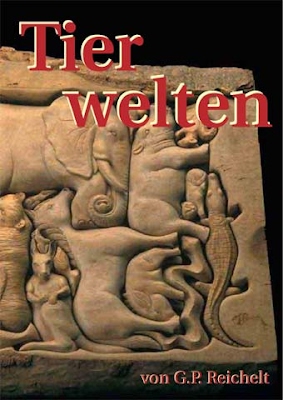
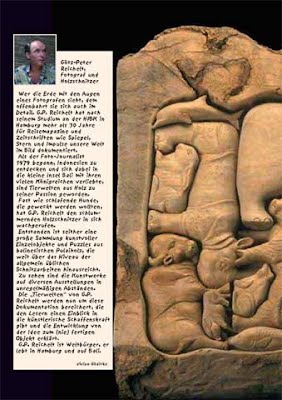

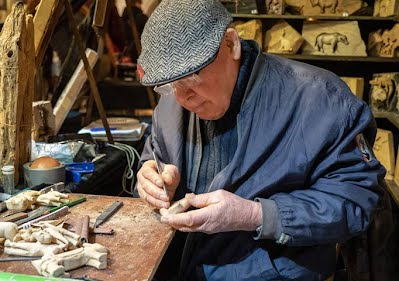
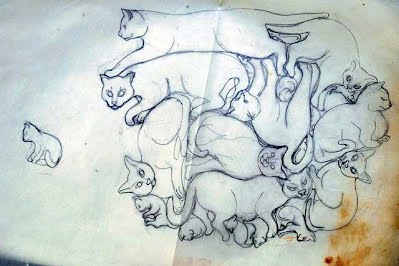

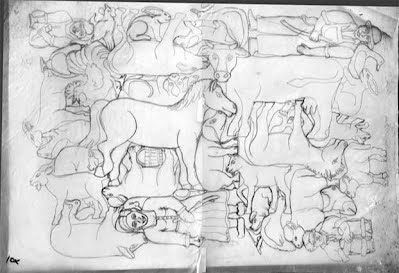
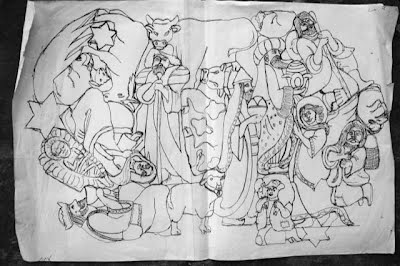
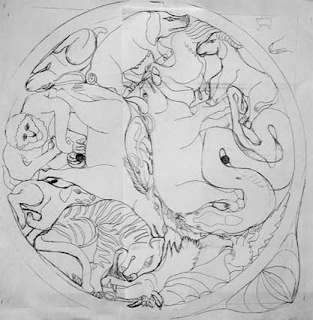
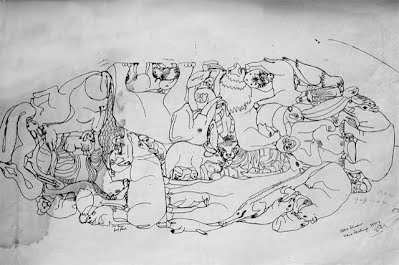
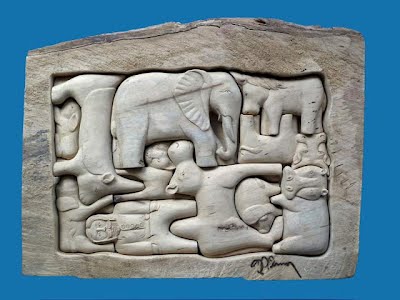
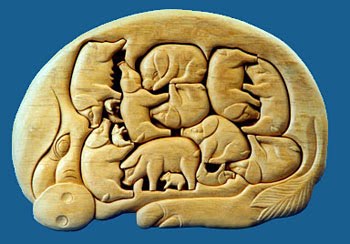
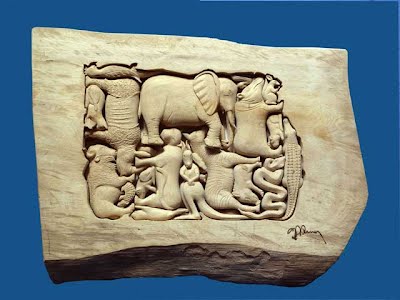
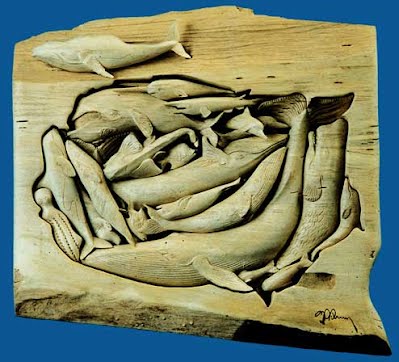
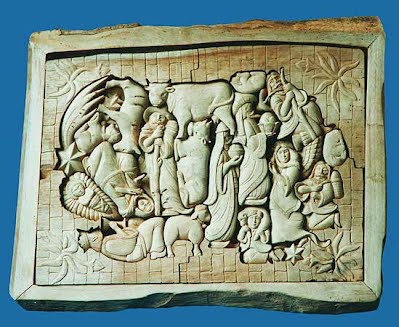


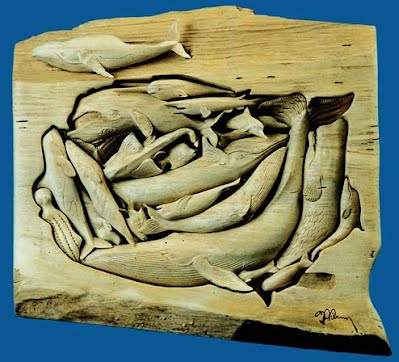
.jpg)
